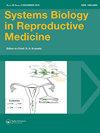排卵前雌二醇浓度对肉牛后续黄体功能的影响
IF 2.1
4区 医学
Q3 ANDROLOGY
引用次数: 1
摘要
据推测,排卵前雌二醇的循环浓度会影响随后的黄体酮浓度。非泌乳肉牛的排卵同步(n = 53)。在促性腺激素释放激素(GnRH)诱导的排卵(d 0)之前表现出发情的奶牛(p.50)。此外,治疗对第0 ~ 20天血浆孕酮浓度没有影响(p= 0.86)。这些结果表明,排卵前升高的雌二醇并不需要为黄体生成或随后的黄体黄体酮分泌准备颗粒细胞,但确实倾向于影响黄体寿命。本文章由计算机程序翻译,如有差异,请以英文原文为准。
Impact of preovulatory estradiol concentrations on subsequent luteal function in beef cattle
Abstract It has been hypothesized that circulating concentrations of estradiol during the preovulatory period, can impact subsequent progesterone concentrations. Ovulation was synchronized in nonlactating beef cows (n = 53). Cows that exhibited estrus before gonadotrophin-releasing hormone (GnRH)-induced ovulation (d 0) had greater (p<.01) peak concentrations of estradiol compared with cows that did not express estrus (11.5 ± 0.8 vs. 6.2 ± 0.6 pg/mL), respectively, but there was no difference in ovulatory follicle size (p= .80) or interval from GnRH2 to ovulation (p=.23). Circulating concentrations of progesterone during luteal formation (d 3–7; p=.70 and p=.77) or mid-luteal phase (d 8–14; p=.39 and p=.12) were not affected by elevated periovulatory estradiol or an interaction with day. To investigate the direct influence of estradiol on luteal function, ovulation (d 0) was synchronized in nonlactating beef cows and cows were allocated to three groups (control, n = 5; vehicle injection, n = 4; or an estradiol antagonist (Fulvestrant; ICI 182,780), n = 4. Intrafollicular injection of vehicle (100 µL) or an estradiol antagonist (25 μg Fulvestrant in 100 µL) into the largest follicle occurred on d –2. Concentrations of estradiol increased (p<.0001) from d –2 to 0 but did not differ among groups (p>.50). Furthermore, plasma concentrations of progesterone on d 0 through 20 were not affected by treatment (p=.86). These results indicate that elevated preovulatory estradiol before ovulation was not required to prepare granulosa cells for luteinization or subsequent luteal progesterone secretion but did tend to impact luteal lifespan.
求助全文
通过发布文献求助,成功后即可免费获取论文全文。
去求助
来源期刊
CiteScore
4.30
自引率
4.20%
发文量
27
审稿时长
>12 weeks
期刊介绍:
Systems Biology in Reproductive Medicine, SBiRM, publishes Research Articles, Communications, Applications Notes that include protocols a Clinical Corner that includes case reports, Review Articles and Hypotheses and Letters to the Editor on human and animal reproduction. The journal will highlight the use of systems approaches including genomic, cellular, proteomic, metabolomic, bioinformatic, molecular, and biochemical, to address fundamental questions in reproductive biology, reproductive medicine, and translational research. The journal publishes research involving human and animal gametes, stem cells, developmental biology and toxicology, and clinical care in reproductive medicine. Specific areas of interest to the journal include: male factor infertility and germ cell biology, reproductive technologies (gamete micro-manipulation and cryopreservation, in vitro fertilization/embryo transfer (IVF/ET) and contraception. Research that is directed towards developing new or enhanced technologies for clinical medicine or scientific research in reproduction is of significant interest to the journal.

 求助内容:
求助内容: 应助结果提醒方式:
应助结果提醒方式:


